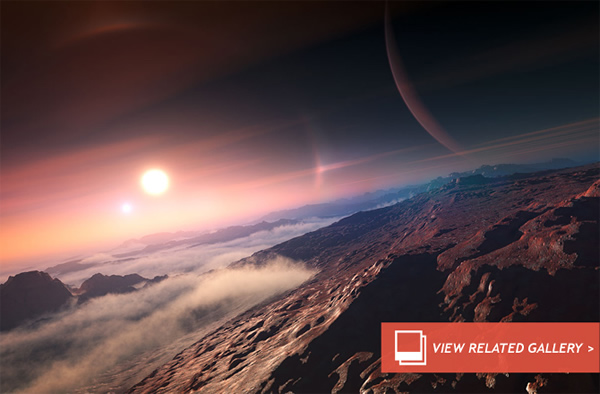First 'Habitable Zone' Galactic Bulge Exoplanet Found
For the first time, astronomers have discovered a sun-like star playing host to a “habitable zone” exoplanet located inside the Milky Way’s galactic bulge — some 25,000 light-years distant — using a quirk of Einstein’s general relativity.
But don’t go having dreams of exotic getaways to the glistening lights of the center of our galaxy, this exoplanet is a huge gas giant world, about five times the mass of Jupiter. However, there is something (potentially) very exciting about this new discovery. Like Jupiter, this newly discovered giant exoplanet may possess small satellites; exomoons that could have life-giving potential.
This massive world was detected through “microlensing.” Microlensing events occur when a star passes in front of another, more distant, star. As the nearer star passes in front, its gravitational field — which is (according to general relativity) bending the surrounding spacetime — deflects the light from the more distant star. Like the lens in a magnifying glass, the starlight is magnified and Earth-bound observatories are able to spot a transient brightening. Information about the “lens” (the foreground star) and any planets in tow can then be deduced in the brightening’s “lightcurve.”
Detailed in a pre-print published on the arXiv, the microlensing event, known as “MOA-2011-BLG-293Lb,” was detected by all three microlensing surveys: the Microlensing Observations in Astrophysics (MOA — New Zealand/Japan), Optical Gravitational Lensing Experiment (OGLE — Poland) and Wise Observatory (Israel). Astronomers then decided to do followup observations of the event using the adaptive optics instrumentation of Hawaii-based Keck Observatory. Keck’s adaptive optics are capable of removing atmospheric aberrations and returning precise measurements of this transient brightening.
Measurements of the MOA-2011-BLG-293Lb’s lightcurve returned information about the lensing star, its planet, their masses and the star-planet distance. The star, determined to be a G-type dwarf star slightly less massive than the sun, is located only 1.1 AU (astronomical units) from the planet. This makes it highly likely (a probability of 53 percent) that the massive exoplanet is orbiting within the star’s habitable zone, albeit on the outer edge, near the star’s “snowline.” This is the first such discovery to be made of a world located in the galactic bulge.
The habitable zone around any star is the orbital distance at which it’s not “too hot” and not “too cold” for liquid water to exist on a hypothetical rocky planet’s surface. It is for this reason that the habitable zone is also nicknamed the “Goldilocks Zone” — it’s just right for liquid water to persist. Liquid water is the stuff believed to be essential for the evolution of life as we know it.
The search for exoplanets of approximately Earth-sized dimensions has been feverish over recent years, but unless we can find planets orbiting within habitable zones of their stars with the potential of possessing liquid water, the life-giving potential of those small worlds seems slim.
But, as the multinational team of astronomers who analyzed MOA-2011-BLG-293Lb hypothesize, the super-Jupiter could play host to its own system of exomoons that would also exist on the outer edge of the star’s habitable zone. Alas, microlensing surveys don’t have the sensitivity (yet) to detect these diminutive satellites, but it is a tantalizing thought.
“Indeed, although the data do not explicitly show any signature of a companion to the Jupiter planet, this possibility is not ruled out,” the researchers write. “The planet is apparently at the edge between the snow line and the habitable zone, but considering a potential greenhouse warming effect, the surface temperature of a possible companion (exomoon) can be suitable for habitability.”
Like the recent discovery of MOA-2011-BLG-322, another microlensing event that detected the presence of another massive exoplanet in the galactic core, this discovery challenges some planetary formation theories. In this case, a super-Jupiter has been discovered orbiting its star at an equivalent distance the Earth orbits the sun. The MOA-2011-BLG-322 and MOA-2011-BLG-293Lb massive exoplanets orbit too close to their stars for them to have formed there. So some mechanism is either causing them to migrate from wider (beyond the systems’ snow lines) to more compact orbits (where they are observed today) or another planet-forming mechanism is at play.
Just the fact that we can detect the presence of exoplanets 25,000 light-years away inside the central bulge of our galaxy is mind-blowing enough, but the fact that this exoplanet exists so close to its star that its (hypothetical) satellites may be warm enough to possess liquid water on their surfaces, well, that really sets the imagination on fire as to the potential for life inside the crowded stellar party that is our galaxy’s central bulge.(Oct 15, 2013 01:57 PM ET // by Ian O'Neill)












